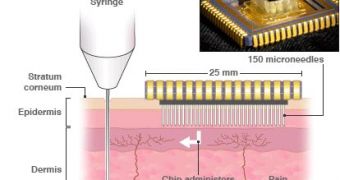Soon, the nasty injections could be a fact of the past as a simple patch, attached to the skin of the arm could deliver drugs to the body, without causing pains. The new technology from inkjet printer cartridges employs a system developed by HP to push drugs through tiny needles, too short to reach the pain receptors.
This method could deliver many drugs now injected or taken daily. Still, the researchers are worried about the possibility of causing infections of the patch.
The biotechnology was developed by the Irish firm Crospon, under the HP license and by 2010 it could be available. By now, only chemicals which can be absorbed directly through the skin, like nicotine, tranquilizers and progesteron, can be delivered using a patch. But most drugs have bigger molecules and cannot do this, requiring a needle to penetrate the skin.
The outer skin layer, called the epidermis stops the entrance of bacteria and viruses into the body. It is only a fraction of a millimetre thick and conventional needles penetrate far beyond into a layer called dermis, which is packed with nerves sending pain and other sensory messages when disturbed.
The pain receptors are located at about 0,75 mm under the skin surface, while the microneedles penetrate just to a maximum of 0.5 mm. A patch would contain about 150 microneedles and the dose and time of delivering a drug could be controlled by a microchip. The patch also contains 400 cylindrical reservoirs that can be filled with the necessary drugs.
"Another benefit of the HP-developed patch was its ability to carry more than one drug at the same time. We think we can deliver both insulin, and glucagon - which counteracts the effects of insulin - which would be of great benefit to diabetics, as one of the greatest risk they face is an overdose of insulin," said John O'Dea, Crospon's Managing Director.
The patch could be used by diabetes patients, but also to replace inhalers used by asthma patients.
"Having a microneedle patch applied to your skin would feel like being "licked by a cat", but not painful. However, the manufacturers would have to demonstrate that making lots of small holes in the skin wasn't letting bacteria and viruses in and causing infection. Certainly there is a lot of potential for microneedles, but you also wonder whether it will end up costing too much to deliver a drug which costs pennies," said Professor Brian Barry, from the University of Bradford, a leading researcher into new ways of administering drugs through the skin.

 14 DAY TRIAL //
14 DAY TRIAL //